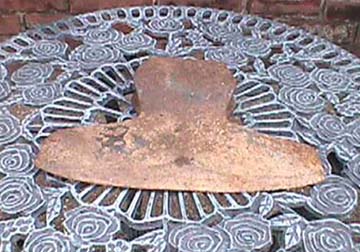
broadax (artifact #9)

A broadax is a tool that was used for years before the sawmill was widely used to saw railroad cross ties and lumber. This tool came into wide use with the advent of the railroad. In some locations spur tracks were actually built to run into the timber areas to bring out the cross ties that were hewn with a broadax. Other uses were for hewing logs into timbers and lumber for building homes. The broadax is to be used with care as one slip in some manner could be disastrous due to the heavy weight of such a long cutting edge. It must be almost razor sharp for good results.
Some fine furniture was made with this tool. I have memories of a cherry-wood chest with drawers, built for my mother by the use of this tool. A broadax is quite large for such fine work, but one can true up a board very well, although it might be a bit slow as it takes careful handling.
Railroad ties were about 6 x 8 or 7 x 9 inches on the sides. The length varied, depending upon their use, from 8 feet for a regular rail line to longer length for switch cross ties.
Operation # 1 : One would stand on the log and, with a broadax, cut a straight line on the top side of the log by slightly hitting the log and moving along the full length with a repetitive action. A mark the full length on the log is thus made.
Operation # 2 : A double headed chopping axe would be used to cut V notches on top of the log, the depth up to the marking line at approximately 18 to 20 inches apart along the length of the line.
Operation # 3 : Then one would use the broadax to cut or pare off the wood on this one side in a rough manner. A second pass would be made to true up and smooth the face cut. The above operations would be done to all four sides of the log. Slab wood, with the bark on, are called juggles when produced this way.
This was hard labor, one needs to be in excellent health to be a woodsman. I truly thank God that work, for myself and this generation, is easier today. There were three generations of Doyles that worked the timber for ties, which is another long story. I have worked the timber making a fourth generation. However, I didn’t use a broadax. The crosscut saw is a very familiar tool to me as I have spent many days felling and bucking timber. I can fell timber, laying a tree where I want it to fall. Sighting the tree is an art. The woodsman’s art is mostly lost today except in the Northwest where timber is the main industry.
I have had fun with the broadax head, handing it to someone and asking if they could determine if it was a left- or right-handed broadax. Most people, not familiar with the tool, will be puzzled due to its odd shape. Actually, the handle can be assembled to the axe head to become either. Most tools have the handle inserted and affixed to the head with the handle inserted from the rear, but in this case, the head has both two fronts and two rears.
Due to the long straight blade being flat on one side and its weight, one can smoothly shave away high spots. I remember a story I heard about hewing ties. It seemed that a log had a hole and was hollow from a limb that had rotted. The void ruined the tie because the finished product was of no value unless it was solid. The log and the labor would be wasted. So the man cut a green sapling and peeled the bark, leaving the pole slightly larger than the hole running back into the tie. He then used the green pole as a plug and drove it home with a mall (large flat-faced hammer). He used the broadax to cut it even with the side of the tie and dress it smooth. The appearance was such that the yard inspector passed it as a quality product.
The broadax head shown in the picture belonged to Fred Doyle. It went through the fire when our home burned to the ground December 4, 1944. This is the reason for the carbonization crust seen in the photo.
Charles D. Doyle 5/19/03